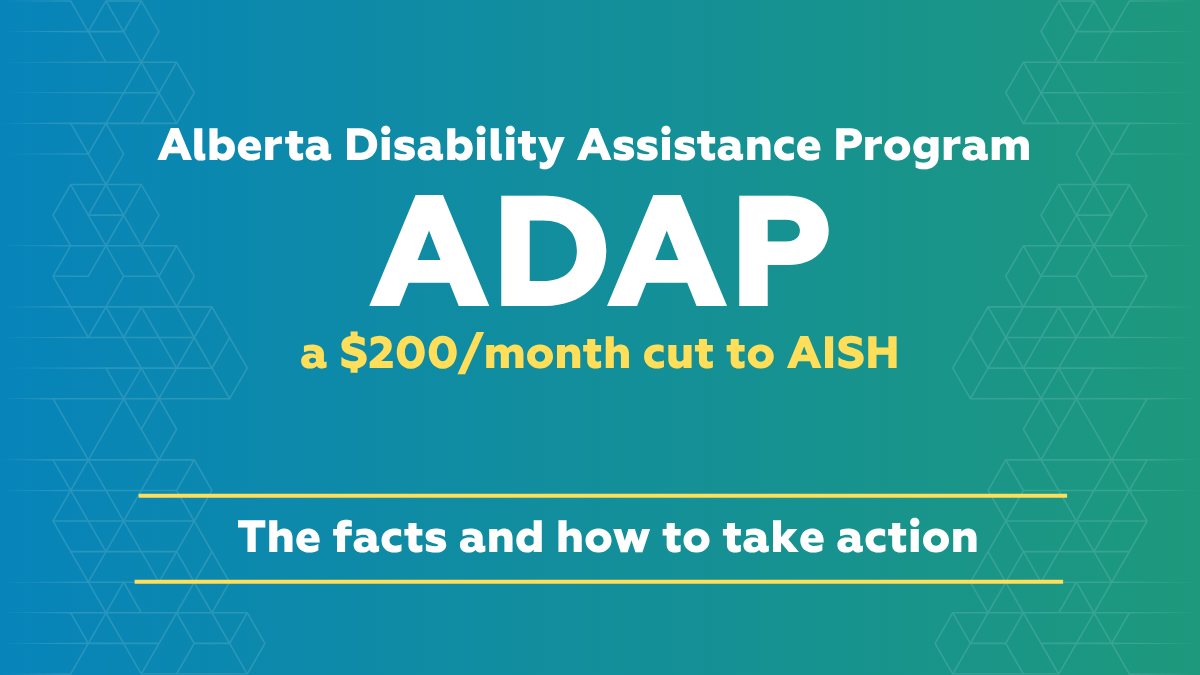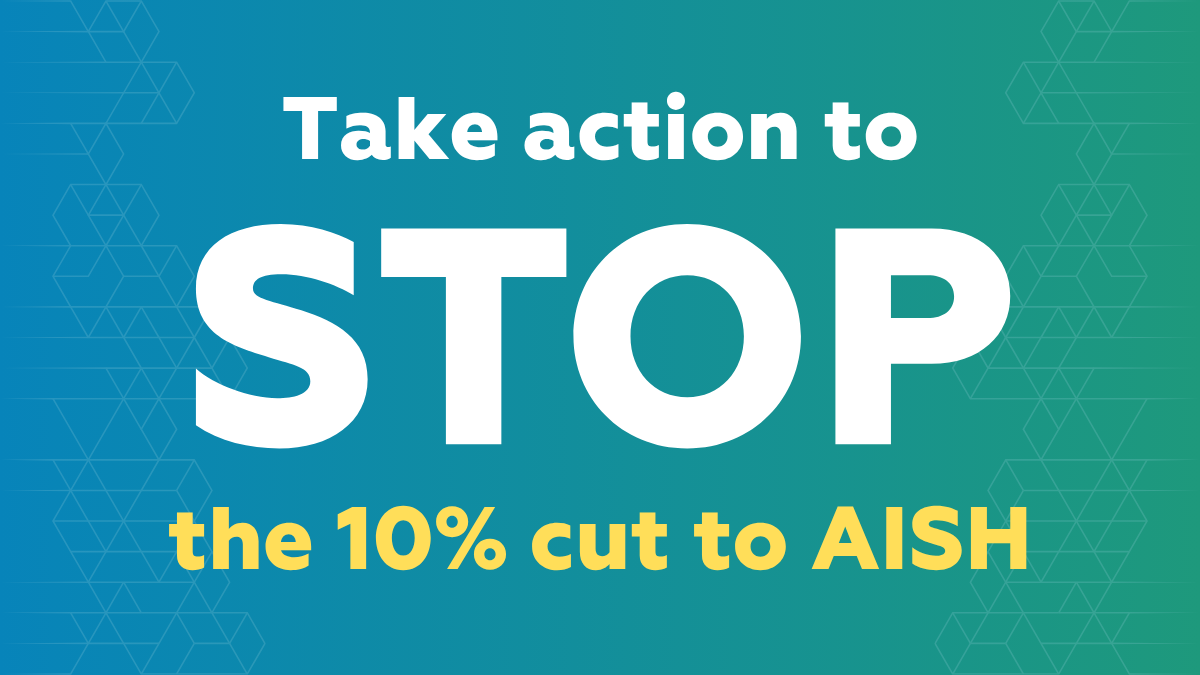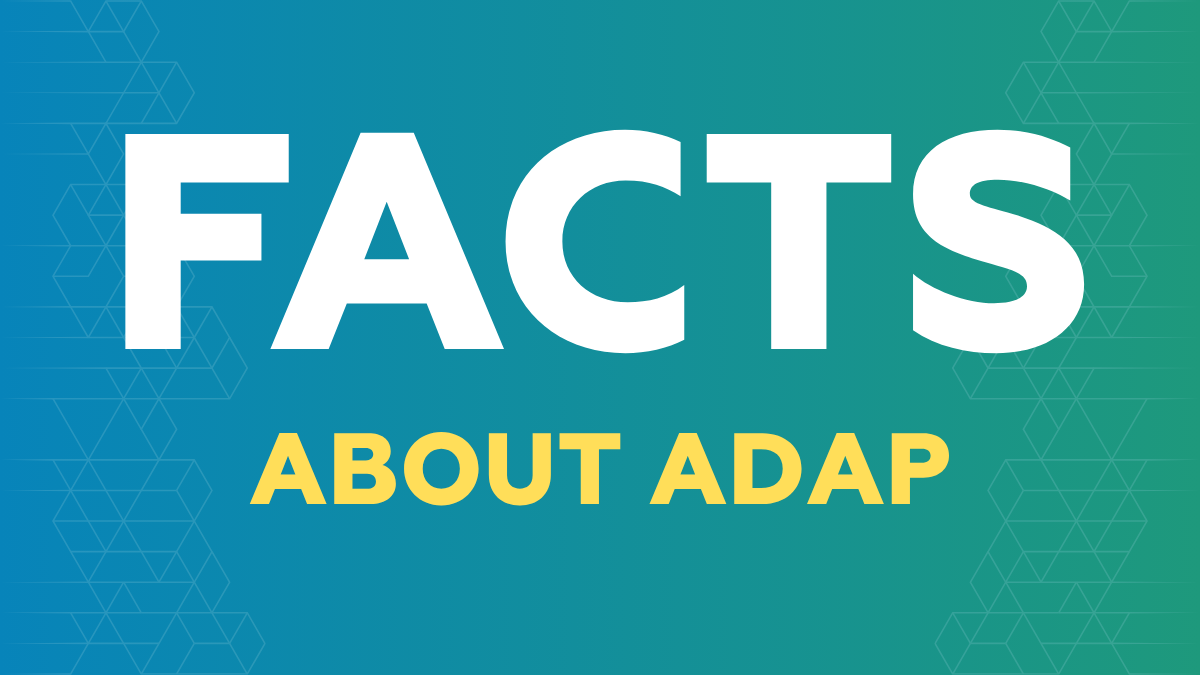Alberta Disability Assistance Program (ADAP) would cut AISH by $200/month. The facts and how to take action

The facts on ADAP and how to take action to stop the cut.
The Alberta Government released the ADAP Discussion Guide in August proposing that all adults with disabilities who receive AISH be moved to the new Alberta Disability Assistance Program (ADAP) effective July 1, 2026, with a benefit that will be $200 per month lower. This 10% cut will worsen an already desperate situation for Albertans on AISH, already below Canada’s poverty line. This follows two earlier blows: the clawback of the $200 Canada Disability Benefit and a $220 per month rent hike for AISH tenants in Community Housing. Even while announcing repeated cuts to individuals with disabilities, the Government of Alberta has responded to the rising cost of living by offering pay increases over 4 years of 20% for nurses and 12% to teachers and AUPE members. MLAs increased their own housing allowance by 14% this year from $1,930 to $2,200.
Individuals and families are increasingly reaching out to Inclusion Alberta expressing disappointment, fear and confusion about ADAP and what it means for them. We have created two resources:
- Take action to stop the 10% cut to AISH, (text follows below) to guide you on how you can take action to oppose the planned cut.
- ADAP Fact Sheet (download PDF), (text follows in drop downs below) as a resource which we hope will aid in clarifying the issues. Plain language version of ADAP Fact Sheet (download PDF)

What you can do to help stop the cut.
The new funding for employment supports that is being introduced at the same time as ADAP is being launched should not distract from the fact that ADAP will cut monthly benefits by $200 and cut employment income exemptions. While increased funding for employment supports may help some, this will not be enough to help most adults with disabilities overcome systemic and attitudinal job market barriers or Alberta’s highest unemployment rate since the pandemic. Tens of thousands are now unsure how they will pay for rent, food, and equipment or medication they require due to their disabilities. Most people with disabilities would welcome policy changes and employment supports that achieve government’s stated goal of supporting them to ‘pursue fulfilling job opportunities.’ Both increasing the extent to which people with disabilities on AISH keep their employment earnings and medical benefits, and offering enhanced employment supports could be accomplished without cutting benefits and creating a new program that brings new administrative expenses for government and fear and uncertainty for Albertans.
Legislation to change AISH and create ADAP will likely be introduced in November. It is urgent that people with disabilities, their families and allies ask government to cancel this plan that will thrust thousands of people with disabilities into deeper poverty.
Actions you can take:
- Request a meeting with your MLA.
- You can use this template to write to your MLA requesting a meeting. We put together a document with contact information and guidance for contacting your MLA. Be clear that as a constituent, you want to speak with them directly about your concerns, not be referred to the Ministry responsible for AISH/ADAP. If they will not meet with you, insist that your opposition to ADAP be noted.
-
- Use this talking points document to guide your conversation with your MLA. A plain language version of the talking points document is available here.
-
- You can leave your MLA a copy of the Whitepaper on the Proposed Alberta Disability Assistance Program (ADAP) published by VanderLeek Law that explains ADAP based on information released to the public by the government.
- Write a letter to the following leaders in government:
- Premier Danielle Smith premier@gov.ab.ca
- Minister Jason Nixon (Ministry of Assisted Living and Social Services) ALSS.Minister@gov.ab.ca
- Minister Nate Horner (Ministry of Finance & President of Treasury Board) tbf.minister@gov.ab.ca
- Deputy Minister Dennis Cooley (Ministry of Assisted Living and Social Services) dennis.cooley@gov.ab.ca
- Acting Deputy Minister Darren Hedley (Treasury Board and Finance) Darren.Hedley@gov.ab.ca
This sample letter to government can be used to email the relevant ministers, politicians and civil servants. We encourage you to personalize this letter, letting the recipients know how the changes to AISH will impact your family and why it is important that ADAP be cancelled.
- Find out about and support events in your community in which people are expressing concern about the cut to AISH.
- Ask your municipal councilors and local business leaders to stand against the cut to AISH with MLAs and cabinet ministers and to raise the issue of the resulting impact on local economies and social supports such as food banks.
- Call upon everyone you have a relationship with and ask them to take the four previous actions. This includes informing other groups you are connected to about the cut to AISH and asking them to inform their members. This could be a service club, faith community, union, business group or voluntary organization. We’ve created a shorter document you can share with them to explain the problems with ADAP.
Resources:
- ADAP Fact Sheet (PDF)
- ADAP Fact Sheet plain language version (PDF)
- ADAP Fact Sheet (shorter version, PDF)
- Sample template letter to request a meeting with your MLA (Word doc)
- How to contact government about ADAP (Word doc)
- Talking points for your MLA meeting about ADAP (Word doc)
- Talking points for your MLA meeting about ADAP plain language version (Word doc)
- Meeting handout to leave with your MLA: Whitepaper on the Proposed Alberta Disability Assistance Program (ADAP) (PDF) published by VanderLeek Law
- Sample template letter to email Premier Danielle Smith and Ministers (Word doc)

Facts about ADAP: Learn more about the proposed Alberta Disability Assistance Program (ADAP)
This summary outlines how the plans for ADAP and the changes to AISH would deepen poverty, punish employment, apply the systemically and individually dehumanizing label of ‘unemployable’ to some Albertans, erode fairness, and increase bureaucracy and administrative burdens. The information below draws on what has been proposed in the ADAP Discussion Guide, the details of which could change before the program is launched in July 2026. Legislation for ADAP and amendments to AISH are expected to be introduced in the legislature in November, with regulations to follow in early 2026.
PODCAST: ‘We Advocate’ is a podcast that you may wish to check out if you are interested in learning more about the proposed new changes to AISH and the new Alberta Disability Assistance Program (ADAP).
The 10% cut from $1,940 to $1,740 for individuals moved from AISH to ADAP will force impossible budget choices. One individual who receives AISH described $200 as “the difference between getting uncovered prescriptions paid for or having groceries for the month. The difference between almost living and barely existing.” The suggestion that tens of thousands of individuals with disabilities on ADAP will secure sufficient employment to be better off than on the current AISH program is unrealistic and misleading and will see thousands driven into deeper poverty.
Costs for basic necessities continue increasing at an even faster rate than the Consumer Price Index and now the cost of a basic standard of living is higher in Calgary than anywhere in the country outside of Vancouver and the territories. Calgarians experiencing a cut from $1,940 to $1,740 will descend below the deep-poverty threshold. Disability-related expenses, estimated at 20% above normal living costs, make the impact even worse.
A $200/month transition benefit delays the cut until January 2028 for those already on AISH when they move to ADAP on July 1, 2026. New applicants after July 1, 2026, such as someone turning 18, will receive only $1,740 per month rather than the 2026 AISH rate of $1,940.
While ADAP claims to reward work, it actually makes a 67% cut to the current $1,072 amount of fully exempt employment income. Single individuals on ADAP will have a percentage of any employment earnings over $350 clawed back. For single individuals on the new AISH, every $1 earned over $350 leads to a $1 reduction in benefits. The decreased exemption means that many people with employment on either ADAP or the new AISH will be financially worse off than they were on AISH, keeping less from their employment and receiving a lower government benefit. The reduced earning exemption would begin July 1, 2026.
Spouses/partners’ employment exemption is cut from $2,612 to $1,500. Increasing the amount to which people are penalized for having an interdependent relationship would make people feel pressure to stay single or hide relationships, weakening personal support networks and increasing emotional isolation. Even when it doesn’t inhibit someone’s ability to form or maintain relationships, this increased clawback of benefits based on spousal employment income is still be harmful because it makes people with disabilities financially dependent on their partners, undermining their independence and autonomy.
Parents on AISH have their employment exemption cut from $2,612 to $350 (AISH) or $525 (ADAP). Decreasing AISH’s higher exemptions for parents would undermine efforts to reduce child poverty.
The Discussion Guide presents case studies to illustrate ADAP’s advantages that are misleading and omits key facts. Someone with employment income of $1,492 per month, as in Case Study 1 in the guide, will actually have $164 less on ADAP than with the current earnings exemptions available through AISH. Based on the best available modeling of how the earning exemptions will work, any single individual earning less than $25,368 annually (roughly 33 hours/week at minimum wage) from employment will have lower income on ADAP than on the existing AISH program. Even individuals able to reapply and get back on the diminished AISH program, will be worse off if they previously were able to make more in employment than $350/month, or if they have a spouse/cohabiting partner who earns over $1,500/month from employment.
The barriers to employment for adults with disabilities are well documented and complex. Even if unemployment in Alberta was not over 8%, the suggestion that tens of thousands of Albertans with disabilities will be able to secure and sustain adequate employment is not realizable. Government has yet to prove that the employment services it is rolling out will be effective in increasing employment for individuals with disabilities. That 83.6% of AISH recipients had no employment in 2023–24 reflects societal ableism and prejudices, barriers in systems like transportation and job markets, and policy choices to fund segregated education and disability supports rather than committing to inclusive education and employment models shown by decades of research to result in better outcomes of real work for real pay. While a few individuals with disabilities who are able to maintain full-time employment will not be hurt, most people with intellectual disabilities who have employment income work part-time. The vast majority of adults with disabilities will be worse off than if AISH were to remain unchanged.
Currently the AISH eligibility requirement related to ability to work is that the disability causes a substantial limitation in the ability to earn a livelihood. The proposal is to change this to be a disability that results in being permanently unable to work. Individuals with a severe disability assessed as having some ability to work would be put on ADAP. This either/or classification is both ableist and dehumanizing, myth dressed up as measurement.
Apart from individuals with the most severe and profound disabilities who require ongoing care or support, those with palliative conditions and those residing in a continuing care home due to a severe and progressive medical condition, the Discussion Guide is silent on who else could qualify for the new AISH. The proposed eligibility criteria for ADAP hinges only on the ability to work, not the ability to secure and retain sufficient employment. Some will be denied AISH because they can technically work, yet unable to find jobs, they will be stuck on ADAP and in deeper poverty. Others may obtain very few hours of employment either due to the limited opportunities available or the constraints their particular disability has on their ability to work more hours, also leaving them in deeper poverty than on the current AISH program.
The dichotomy between those who can and cannot work ignores the spectrum of ability and the role of accommodations and supports in enabling employment. Almost every person, regardless of diagnosis or severity of impairment, has the potential to contribute meaningfully through work with appropriate support and accommodation. Limiting AISH recipients’ ability to work and freezing their income at the level of AISH plus $350 should they obtain employment, not only undermines inclusion but actively fosters isolation and financial insecurity. Even minimal work should be recognized and rewarded.
Under the current proposal, all AISH recipients will be automatically transferred to ADAP. They may requalify for AISH if deemed “permanently unemployable” but not if assessed as having ‘some’ ability to work. A new Medical Review Panel will be appointed to make these decisions but it is unknown how impartiality and neutrality will be ensured, and whether the process will give greater weight to the opinions of the medical professionals on the review panel than to the opinions of the medical professionals who have a history treating the applicant and who complete the application form. The Medical Review Panel’s decisions would be final, and individuals would no longer have the right to appeal eligibility to the Citizens Appeal Panel that is impartial and independent from AISH program administration.
ADAP introduces a new administrative apparatus to administer a new program, wastes healthcare resources reassessing individuals, and burdens individuals with disabilities with navigating a new adjudication process to re-prove their disability status. The government is expecting individuals who have previously established that they experience a substantial limitation in their ability to earn a livelihood because of a permanent disability to navigate a new assessment process, obtain assessments from medical practitioners that they may wait months to see and then pay out-of-pocket for. Unless significant support is provided to individuals with disabilities to navigate this new bureaucratic process within the 18–month transition period, hundreds or thousands who should be eligible for AISH will not get back onto AISH and their income will be cut by 10%.
Despite government claims, Inclusion Alberta and other disability organizations report that they were not meaningfully consulted on the need for ADAP or its proposed design. Rolling out ADAP has created widespread fear and uncertainty, with minimal transparency. No one asked to have their income support reduced by over 10%.
ADAP fails at the objective offered by the government of ensuring that people with disabilities “not be punished for getting a job.” Given that the proposed design for ADAP fails at this objective, and would deepen poverty, punish employment, dehumanize and isolate people by labeling them as unemployable, erode fairness, and expand bureaucracy and red tape, there is no need for a new program. Individuals currently on AISH already benefit from employment income through earning exemptions. Inclusion Alberta is calling for the cancellation of ADAP and instead improving AISH by reducing earning clawback rates, ending the clawback of CDB and EI, enhancing employment support and extending health benefits to individuals who earn too much to receive a monthly benefit.
